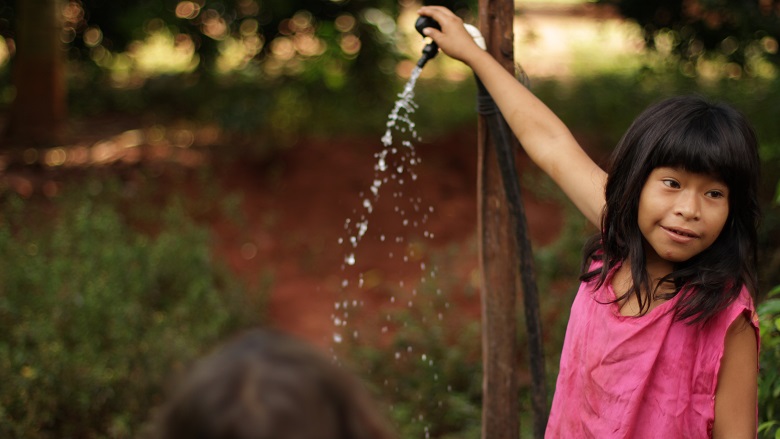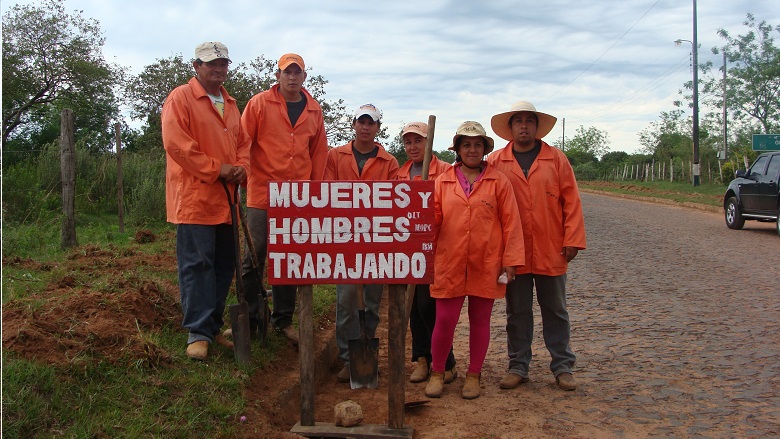Challenge
Paraguay has achieved impressive economic and shared prosperity over the last 15 years. The economy grew at 4 percent per year on average during 2014-2017, slower than the annual 4.7 average growth seen between 2004-2014, but faster than most of its regional comparators. Paraguay’s rapid growth in the past decade is the result of exploiting its fertile land, its water resources and hydroelectric energy, enabled by sound macroeconomic management. The country’s growth was largely driven by agriculture and, to a lesser extent, hydroelectric generation, exploiting the country’s traditional comparative advantage in natural capital. Due in large part to the strong performance of the agricultural export (soy and beef), Paraguay stands out in the region for the positive contribution of net trade to growth.
Paraguay faces major challenges in achieving sustainable and inclusive development. Access to basic services and provide quality service delivery to its citizens remains a challenge and even more so in rural areas. With about one third of the population living below the poverty line, poverty is even more pervasive in rural areas where 50 percent of the population lives in poverty.
While over 80 percent of the population in urban areas is served by a network water connection, only 44 percent have similar access in rural areas and only 15 percent of urban residents have access to a network sewerage connection. Being landlocked makes Paraguay heavily dependent on road and fluvial transport to connect with neighboring countries for its exports. The significant shortfalls in the quality of the transport infrastructure add to this burden. The challenges go beyond the road network, both port capacities and air transport system need administrative, technological and infrastructural improvements in order to cope with rising demand.
Though Paraguay has been characterized by high economic growth, strong poverty reduction and macroeconomic stability in the last 15 years, important challenges remain in the current composition of growth and risks to its sustainability. To deliver a lasting and sustainable creation of wealth, especially for the bottom 40 percent, Paraguay’s development model must evolve. First, the incorporation of land to the productive process should be limited by the need to contain deforestation and avoid depleting Paraguay’s natural capital, shifting the focus of agricultural production to increasing productivity. Second, human capital must play an increasing role in economic growth. The demographic dividend will continue for the next few decades, but its contribution to growth impact will slowly decline. Educational attainment has increased in recent years, and this trend should be matched by improvements in learning outcomes. Social protection policies should also need to focus more on human capital generation, assigning more resources to children (and, particularly, early childhood development). The growth of the youth population—which requires an estimated 65,000 new jobs every year until 2030—combined with the rapid and insufficiently planned urbanization process, will demand a dynamic economy and efficient public policies that promote job creation, particularly in urban areas. Lastly, institutional changes are taking place, and will need to advance rapidly to respond to expectations of the population, especially for young people.
Approach
The World Bank program is supporting Paraguay by financing projects in strategic areas such as rural development, water and sanitation, energy and roads, and through reimbursable and non-reimbursable technical assistance. The advisory services expanded considerably, covering topics ranging from financial inclusion to agricultural risk, from macroeconomic volatility to education, from state owner enterprise (SOE) reform to poverty/equity analysis and public expenditure reviews in the social sectors. Some of the analytical work has resulted in tangible outcomes, such as the Bolsa Agrícola (operational since December 2017) which provides more transparent and predictable prices for Paraguayan grains. Additionally, the Doing Business advisory work on promoting formalization of the economy has helped to reduce the hurdles to company registration, simplifying insolvency mechanisms and improving access to credit for small & medium enterprise (SMEs) through secured lending and has resulted in a bill that is currently at discussion in Congress. Analytical work on financial inclusion was followed by the implementation of a national strategy by the Government leading to a 350 percent increase in the number of adults with accounts since 2011. The substantive analytical work on fiscal policy and equity has provided as a basis for the current dialogue on fiscal reform and tax progressivity in course. The demand for WBG advisory services remained high and led to an important engagement through RASs on strategic areas for Paraguay, such as governance, transparency, management of the environment and education.
Results
World Bank (IBRD) financing helped to achieve the following results:
- Improved the agricultural productivity: The Sustainable Agriculture & Rural Development Project (PRODERS), the main Government tool to fight rural poverty, has reached overall 260,000 beneficiaries corresponding to 48,251 households between 2009 to 2019, who benefited from agricultural services, particularly technical assistance. A random sample of 1,029 households comprising beneficiaries from 2011 to 2016 who benefited from the estrategia campesina (strategy for farmers) recently took place and concluded that 24,875 poor households in Eastern Paraguay are expected to report an increase in real agriculture incomes by 2018. At the local level, the Project has also built significant capacity and commitment in more than 600 rural communities to plan and execute local development interventions. As a result, 180 indigenous communities prepared and are implementing socio-economic development plans by 2018, highly surpassing the target of 130 communities.
- Improved access to quality water and sanitation services: The Water and Sanitation Sector Modernization Project has contributed, between 2010 to 2019, to the rehabilitation of 57 km of water distribution networks and 8.4 km of sanitation networks in Great Asuncion. About 270,000 people, 10% of the population in the capital Asuncion have access to improved sanitation environment. The project has contributed to improve rural water and sanitation infrastructure, already benefiting 6,190 indigenous individuals, half of whom are women. In addition, the project has also supported the decentralization of the National Environmental Sanitation Services (SENASA), as well as the development of an action plan to support the Water and Sanitation Units of the municipalities in Chaco to ensure long-term technical, institutional and financial support to all indigenous communities.
- Improved road infrastructure in target areas, particularly benefiting the rural population: The Road Maintenance Project expanded rural connectivity and helped strengthen government capacity to define investment priorities and develop efficient work programs aligned with existing budgets. Institutional improvements have also been supported by legal actions in five key areas: passage of a transit and road safety law; passage of law to amend the classification of road system; creation of a planning department in Minister of Public Works (MOPC for its acronym in Spanish); increase in toll rates to cover costs of the system; and creation of a department for transparency and public participation. The Project financed improvements to about 141 km of unpaved roads and many bridges in the three targeted departments and contributed to the introduction of performance-based contracts, with three contracts implemented for a total of 624 km between 2008 to 2016.
- Increased efficiency of the electricity transmission network: The Energy Sector Strengthening project financed between 2014 and 2018 a 23 percent increase in energy supplied trough 21 improved or new transmission stations. It also helped increase by 30 percent the quality of electricity supply benefiting 2.5 million people in the Asuncion Metropolitan Area (of whom approximately 15 percent are below the national poverty line). In addition, the project was successful in helping modernize ANDE’s control and communication system by financing a SCADA system and a 3000 kilometers fiber optic network that, as a whole, is helping improve the quality of the electricity service.
World Bank Group Contribution
The World Bank’s active IBRD lending portfolio in Paraguay totals US $401 million and consists of four investment lending projects: Rural Development, Improvement of Electricity Delivery, Transport Connectivity, and Improved Water and Sanitation. The Transport Connectivity project (US$100 million) became effective in January 2018. The Reimbursable Advisory Service (RAS) portfolio (US$5m) in Paraguay started in 2016 and has been very successful to date in channeling demand for knowledge services to high-priority areas. The RAS portfolio includes activities – some of them already concluded - with the Central Bank, the Social Protection Institute (IPS), Itaipú Binacional, Minister of Finance, Minister of Education and Ministry of Health. Two new RASs are in preparation in the social protection and public procurement sectors
Partners
The World Bank has maintained close partnerships with other donors, especially the European Union in the education and social protection agenda, United Nations in agricultural sector and the Interamerican Development Bank in infrastructure initiatives. Partnerships are also promoted with leaders from the private sector such as the Club of Executives of Paraguay and civil society organizations such as Club de las Ideas and Paraguay Debate to promote dialogues on the country's development challenges.
Moving Forward
On January 22, 2019 the World Bank approved a new Country Partnership Framework (CPF) for the period FY19 to FY23 (Report No. 131046PY) that is aligned with the objectives of Paraguay’s National Development Plan 2030 (NDP) and the five-year strategy laid out by the current Abdo Benitez Administration in its Plan de Gobierno 2018-2023 “Paraguay de la Gente”. The CPF is built around three focus areas: (i) promoting accountable institutions and an improved business climate; (ii) natural capital management and integration into sustainable value chains; and (iii) building human capital. In addition, recognizing that socio-economic progress is highly contingent on strengthening the social contract between the Government and the population, the CPF also encompasses a cross-cutting emphasis on transparency, results-orientation and accountability.
Beneficiaries
Librada González, a rural producer and beneficiary of the Sustainable Agriculture & Rural Development Project (PRODERS), carefully arranges the products of her garden in two large baskets to take them to the municipal market of Caaguazú, about 20 kilometers from her farm, in the community of Cantera Boca, in the east of the country. Librada, along with 20 other women, works in a community garden whose products are sold at the weekly village fair. To become small producers, they have received financial support and training to produce sustainably. "Thanks to our garden we have a weekly income with which we can feed our children and buy school supplies," says Librada.



